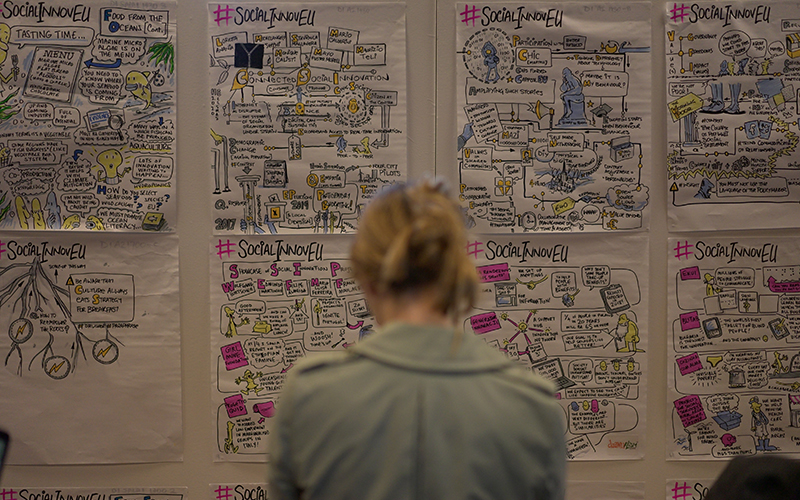
Cohesion and Social Integration Programme
Objective
Contribute towards constructing a fairer society, with solidarity and commitment towards the most vulnerable groups in the population.
Vision
Test and implement innovative approaches responding to social challenges, deploying new tools for financing and managing social organisations.
Targets / Beneficiaries
The different vulnerable groups in the population – especially children and young persons at risk, the elderly and migrant communities.
In terms of empowerment activities, the targets of Programme interventions are the different carer profiles identified alongside technical staff at social organisations.
Action strategy
The Program seeks to establish and nurture new dynamics in the social field that boost the potential of this sector, contributing towards the construction of a more cohesive society with fewer incidences of social exclusion.
The adoption of these new approaches proves necessary due to the growing scale, scope and complexity that these social issues now assume – particularly as regards issues related to ageing, child and youth protection, migratory movements – and for which there is a lack of sufficient and/or appropriate responses.
The response to these social challenges to a large extent comes from organisations in the tertiary sector or the social economy. These organisations face serious challenges as regards their effectiveness and financial sustainability.
Focusing on this space and its scope for innovation, this Programme seeks to explore both in terms of support for the development of better responses to the vulnerable groups identified in the ways in which these responses get financed.
The Programme contains three strategic axes:
Innovation and Social Investment
Social innovation interlinks with the search for and the consolidation of more efficient and effective ways to meet the social needs of our communities. The actors in these new solutions are to a large extent organisations operating in the tertiary sector or the social economy. These organisations face serious challenges as regards their own effectiveness and sustainability. In parallel, social organisations confront challenges as regards their models of governance and leadership.
Another of the questions under debate by social organisations deals with their own sustainability and the scale of the new solutions they implement, decisive factors to their levels of impact. In this aspect, the recourse to new technologies has proven to be a fundamental instrument to boosting the potential range of the solutions promoted with a growing number of technologically based social innovation projects. Finally, there is a growing level of recognition as to the role the arts may play in the integration processes of more vulnerable population groups.
Hence, as regards the Innovation and Social Investment axis, the following reflect the core objectives and expected results:
Wellbeing and Quality of Life
The Wellbeing and Quality of Life axis particularly focuses on reducing the factors of risk and boosting those able to provide protection to two vulnerable population groups: children and the elderly.
The European Commission, the OECD and UNICEF are unanimous in their recommendations regarding the need to invest in education and the provision of care in the early years of life, especially in the 0 to 3 age range.
Integrated approaches, with concerns as regards the level of personal, social and cultural competences, healthy and balanced development from the physical and cognitive perspective but also in emotional terms, enable the development of life projects offsetting any disadvantages experienced at the outset
On the other hand, the ageing of the population, resulting from the increase in longevity and the reduction in birth rates, represents one of the greatest challenges of the 21st century.
According to the United Nations, this requires prioritising development, health and wellbeing and alongside fostering environments favourable to ensuring that everybody may age in safety and with dignity, maintaining their participations in society as citizens with full rights throughout the final years of life; guaranteeing active, healthy and successful ageing processes.
Furthermore, the World Health Organisation identifies the need to guarantee the social support for living securely and independently at home and in the community in keeping with ageing processes.
Hence, the Wellbeing and Quality of Life axis defines the following as the key objectives and results to be achieved:
Migration
The Migration issue (across its two dimensions: immigration and emigration) represents one of the major themes on the current world agenda. As more than demonstrated by the refugee crisis of 2015, this issue shall traverse the entire 21st century as one of the central themes to modern societies incorporating highly distinct realities: ranging from economic migrations (by option) to forced migrations (refugees resulting from armed conflicts, natural disasters, religious and/or ethnic persecution, among other situations).
The Foundation correspondingly seeks to continue to position itself nationally as a benchmark reference as regards the pre-empting of problematic issues and internationally as the “ambassador” of a country that stands out from the great majority of member states due to its humanist and person centred vision, fostering innovative and replicable best practices.
Hence, as regards the Migration axis, the following account for the key objectives and results targeted:
